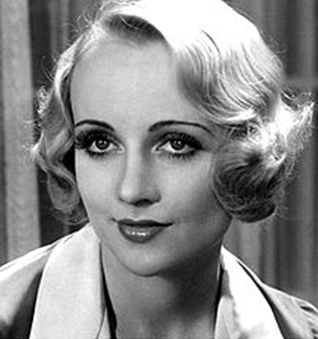

Graham Greene praised the "heartbreaking and nostalgic melodies" of her faster-than-thought delivery. "Platinum blonde, with a heart-shaped face, delicate, impish features and a figure made to be swathed in silver lamé, she wriggled expressively through such classics of hysteria as Twentieth Century and My Man Godfrey."
Career
Lombard made her film debut at the age of twelve after she was seen playing baseball in the street by director Allan Dwan; he cast her as a tomboy in A Perfect Crime (1921). In the 1920s, she worked in several low-budget productions credited as Jane Peters, and later as Carol Lombard. Her friend Miriam Cooper helped Lombard land small roles in her husband Raoul Walsh's films. In 1925, she was signed as a contract player with Fox Film Corporation (which merged with Daryl Zanuck's Twentieth Century Productions in 1935). She also worked for Pathé Exchange and appeared as one of Mack Sennett's Bathing Beauties in 1928. She appears in the title role in Sennet's comedy The Campus Vamp that year. She made a smooth transition to sound films, starting with High Voltage (1929). In 1930, she won a contract with Paramount Pictures after having been dropped by both 20th Century and Pathé Exchange.
In the early 1930s Lombard achieved a few minor successes via 1930's Safety in Numbers with Charles "Buddy" Rogers and 1932's No Man of Her Own with Clark Gable. It was not until 1934 that her career began to take off. That year, director Howard Hawks encountered Lombard at a party and became enamored with her, thinking her right for his latest project. He hired her for Twentieth Century, alongside stage legend John Barrymore. Lombard was at first intimidated by Barrymore, but the two quickly developed a good working rapport.
Also in 1934, she starred in Bolero with George Raft and it was for this film that she turned down the role of Ellie Andrews in It Happened One Night. In 1935 she starred in Mitchell Leisen's Hands Across the Table which helped to establish her reputation as a comedy actress. 1936 proved to be a big year for Lombard with her casting in the screwball comedy My Man Godfrey alongside ex-husband William Powell who refused to do the film unless Lombard was cast opposite him. Although divorced, Lombard and Powell remained friends until her death. Her performance earned Lombard an Academy Award nomination for Best Actress. Her next film was Nothing Sacred in 1937, casting her opposite Fredric March and under the direction of William A. Wellman. It was Lombard's only film in Technicolor and a critical and commercial success. Nothing Sacred established her as one of the highest paid actresses in the business.
Following the failure of Fools for Scandal Lombard moved on to dramatic films for the next few years. In 1939, Lombard took roles opposite James Stewart in producer David O. Selznick's Made for Each Other (1939) and Cary Grant in In Name Only (1939). She also starred in Vigil in the Night in 1940. Audiences did not respond as well to Lombard in dramatic roles; she made a return to comedy, teaming with director Alfred Hitchcock in Mr. & Mrs. Smith (1941). The film gave Lombard's career a boost and she followed its success with what proved to be her last film, and one of her most successful, To Be or Not to Be (1942).



















